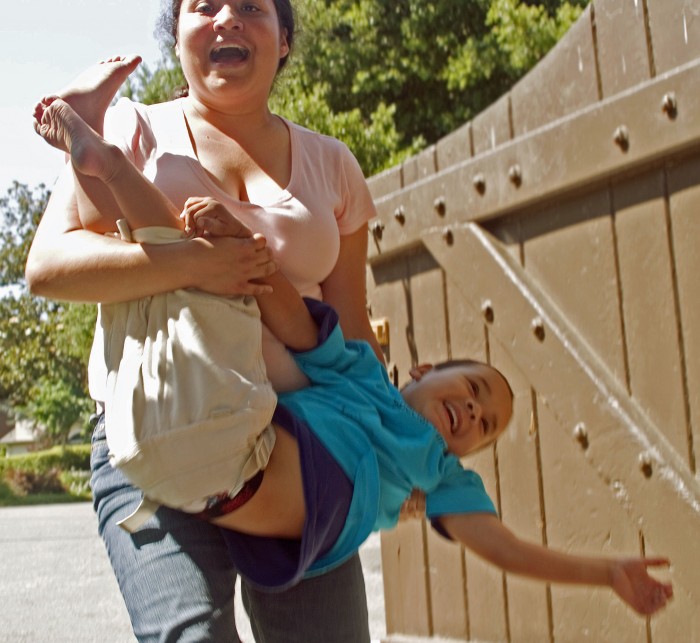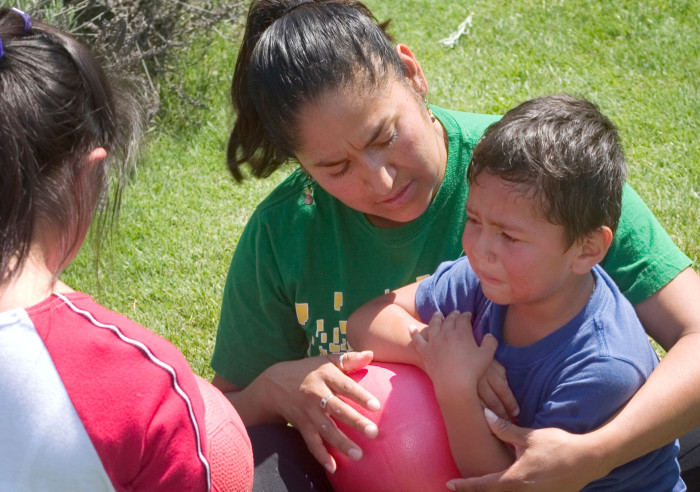Q. I'm struggling a bit with my 5-year-old speaking in a way that pushes my buttons. It's that sassy, sing-songy with a strongly grumpy undertone way of speaking. Think “hands on hips.” If you think you know this tone, yes, that's the one! I'm confused, though, about whether this is a behavior that is appropriate to limit? Or is it a sign that she's gone off-track and needs me to listen to her to vent it off? Any advice? Suggested words to use when talking about it with her would be greatly appreciated, too. Thanks!

I certainly do know the sassy tone you mean and responding to it can be challenging for parents! Children know that their parents are committed to them, so with their parents, their feelings are closer to the surface. They put out bids for attention that they wouldn’t dare try in other environments. It's a compliment to you–you've created an emotionally safe environment, in which your daughter trusts that she doesn’t always have to hide the tensions she feels.
I think one signal that a child is “off track” is plenty. Seldom do children's minds right themselves without help. It's always better to respond when only one signal has been given: by the second or third signal a child puts out, you've become upset, you feel victimized, and in that emotional state, you’re far less able to respond thoughtfully. Waiting is like allowing a runaway puppy to get three blocks away before you start to try to catch it. Three feet of running gives you enough information to decide that it's time for the leash. One signal that says, “I don't feel connected to you” is an invitation to step in, playfully or thoughtfully. More signals will come if no one connects, but every signal will be more irritating than the last.
Restore the Connection after a Sassy Tone Takes Over
In intervening, your goal is to restore the connection between you and your child. It’s that sense of connection that will help your child think, cooperate, and make good decisions. Punishment, criticism, or time out will just intensify the distance between you and your child. Children’s minds don’t abide emotional distance. They are built for a sense of warm connection. It’s the sense of distance (not just the behavior that signals the distance) that’s the underlying problem. Here’s how you can bridge it.
You might want to begin by saying something simple that gives her some necessary information. “I don't like it when I hear people talk that way,” is honest and clear about your response, without blaming her. Or, “I like it better when you speak kindly to me.” If your child can change her tune, she wasn’t far off track, and you will have guided her back into thoughtful communication.
Playful intervention
 If her response is a glare or further signs of a negative attitude, she needs more than a touch of help. Playful intervention is a good next move—you offer her your warmth and creativity. You could grab a handy stuffed animal or pet, and warmly say, “I’m Mr. Fuzzy, and I’m here to inspect the ears of my friends. You sound like you may have an earache! May I see your ear, please?” and place Mr. Fuzzy’s nose in one ear, then the other.
If her response is a glare or further signs of a negative attitude, she needs more than a touch of help. Playful intervention is a good next move—you offer her your warmth and creativity. You could grab a handy stuffed animal or pet, and warmly say, “I’m Mr. Fuzzy, and I’m here to inspect the ears of my friends. You sound like you may have an earache! May I see your ear, please?” and place Mr. Fuzzy’s nose in one ear, then the other.
Another playful intervention would be “Come here, you!” with a playful tackle, or “I think I see some elbows that are feeling very lonely!” accompanied by a chase to plant kisses on her elbows, or “Hmm, I’m getting the ‘Mommy, you're a cabbage!' message! Here I come, your very best Cabbage Mommy!” with ruffling of hair or playful tackle, or any other warm and silly kind of contact, to try to get laughter started.
You could also playfully exaggerate your reaction, “Oooooo! I can't stand hearing that sassy tone of voice!” and run away covering your ears or try to hide your head under their arms, etc. Or you could play the baffled parent, “Did you hear a sassy someone in this room?” looking under the furniture and behind the doors, trying to find the “offender.”
Your child’s response will let you know more about the weight of the upset she’s carrying. If she is able to laugh and enjoy the invitation to play that you’ve offered, you can peel the grumpy feelings from her with a few more moments of play and laughter. The laughter restores her sense of connection. If there are heavier tensions rumbling underneath her attitude, then your bid to play will intensify her upset. She’ll respond with more “attitude.”
At this point, play won’t help. A limit will. Get close, offer eye contact, and say something like, “I can't let you talk to me like that. Come sit with me for a minute. Tell me what’s the matter.” Then, listen. If your child continues to be sassy, keep reaching for her. Tell her, “Honey, something made you feel bad, and I really want to know what happened.” You’re trying to slow down her verbal outbursts enough so that she can feel the feelings that fuel her attitude. Getting close, being sure that she’s a good person, and insisting that she needs to stop, without threatening her, will help her feel safe enough to eventually burst into tears or a stormy rage. This is progress.
Freedom of the mouth

Give your child “freedom of the mouth” while she is having a tantrum or crying. During tears and stomping or thrashing, the child is in the middle of a healing process, and is expressing her hurt feelings as best she can. Saying those feelings and showing them through tears or tantrums diffuses their power. It doesn't make sense to require good manners while a child is releasing poison thoughts in the midst of a good hard cry. You want those out, not in. But if there's no crying, no body heat, no trembling, nothing wet or lively, keep setting the limit until she can get to the hot, lively healing process. We call this kind of listening “Staylistening.” It’s simple, and deeply effective at restoring a child’s sense of closeness and sweet contentment.
I hope that helps! Life is messy, so don't expect to figure it out perfectly each time! But this may give you something to guide you through times that few of us have seen handled with love and generosity.
Yours with great respect for the thoughtful job you're doing!
Patty

